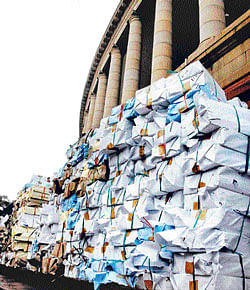
To manage the increasing demand and supply gap of power in the rural areas, the Bangalore Electricity Supply Company (Bescom) way back in 2004, aimed at providing adequate power to IP set consumers as well as non IP set consumers by dividing the feeders.
The project also claimed of managing peak load demand as well as preventing transmission and distribution losses. The CAG which took up performance audit in three Electricity Supply Companies (Escoms) of Bangalore, Mangalore and Hubli, has found that the scheme was taken up without proper planning and there was no scrutiny by technical audit. In Bescom and Hescom, higher capacity equipment materials were utilised for the scheme than specified, which resulted in expenditure of more than Rs four crore.
The CAG report also mentions how the poor maintenence led to the failure of the scheme as the RLMU boxes comprising of circuit breaker, modem and electronic meter (to measure consumption at feeder level) were found tampered so badly that there was a sharp increase in gap between the demand and supply.
Stating that the scheme aimed at arresting demand and supply gap failed badly, the CAG has stated that in six test divisions of Bescom and five test divisions of Hescom, the loss incurred was to the tune of Rs19.72 crore and Rs 8.62 crore respectively.
Bescom stopped implementing RLMS in August 2008, while Hescom shelved the scheme in January 2009. Interestingly, the scheme has been a success in Mescom and the CAG has a word of appreciation that the scheme is, indeed, viable if implemented according to government policy.
‘Never’lasting solution
Initially, the Bescom decided to implement RLMS in 282 feeders (one third of total) at a cost of Rs 195.43 crore. It was increased to 315 feeders later and Bescom even informed Karnataka Electricity Regulatory Commission that it has found an everlasting solution to peg the divide between demand and supply.
Of the total 731 feeders in the State where RLMS was implemented, work on 631 feeders were complete. Bescom and Mescom implemented the work with their own funds. Hescom obtained a loan of Rs179.39 cr from Rural Electricity Corporation and paid an interest of Rs19.39 crore while the principal amount is still due. CAG noted that Bescom Vigilance way back in 2008 itself had mentioned about the tampering.
Interestingly, when the RLMS was in Phase-1 in November 2007, the then Minister for Public Works and Energy, and Managing Director, KPTCL, who was chairman of all Escoms directed that the RLMS work be taken up in one go (on 835 feeders). Bescom floated tenders for Phase -2. It was later shelved by Bescom and another scheme ‘Niranthara Jyothi’ was brought in. Under this a separate 11 KV feeder was drawn to supply power to IP sets at a cost of Rs 735 crore.
The CAG had has also indicted KPTCL for paying over ~ 1,000 crore to Tannirbavi for procuring power from the company in early 2000. Between 2004 and 2009, the KPTCL had lost over Rs 300 crore due to various projects, including injudicious purchase of equipment and their idling.
Related stories